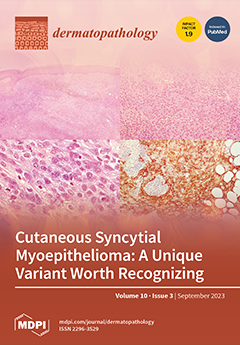Leiomyomas are smooth muscle-derived benign neoplasms that can affect all organs, most frequently in the uterus. Fumarate hydratase gene (FH) mutation is characterised by an autosomal dominant disease with increased occurrence of renal tumours, but also by cutaneous (CLs) and uterine leiomyomas (ULs).
[...] Read more.
Leiomyomas are smooth muscle-derived benign neoplasms that can affect all organs, most frequently in the uterus. Fumarate hydratase gene (FH) mutation is characterised by an autosomal dominant disease with increased occurrence of renal tumours, but also by cutaneous (CLs) and uterine leiomyomas (ULs). So far, an increased occurrence of skin tumours in non-mutated patients with ULs has not been verified. To this aim, a case-group of women who were FH non-mutated patients surgically treated for ULs (
n = 34) was compared with a control-group (
n = 37) of consecutive age-matched healthy women. The occurrence of skin neoplasms, including CLs and dermatofibromas (DFs), was evaluated. Moreover, the microscopic features of FH non-mutated skin tumours were compared with those of an age-matched population group (
n = 70) who presented, in their clinical history, only one type of skin tumour and no ULs. Immunohistochemical and in vitro studies analysed TGFβ and vitamin D receptor expression. FH non-mutated patients with ULs displayed a higher occurrence of CLs and DFs (
p < 0.03 and
p < 0.001), but not of other types of skin tumours. Immunohistochemistry revealed a lower vitamin D receptor (VDR) expression in CLs and DFs from the ULs group compared with those from the population group (
p < 0.01), but a similar distribution of TGFβ-receptors and SMAD3. In vitro studies documented that TGFβ-1 treatment and vitamin D3 have opposite effects on α-SMA, TGFβR2 and VDR expression on dermal fibroblast and leiomyoma cell cultures. This unreported increased occurrence of CLs and DFs in FH non-mutated patients with symptomatic ULs with vitamin D deficiency suggests a potential pathogenetic role of vitamin D bioavailability also for CLs and DFs.
Full article





